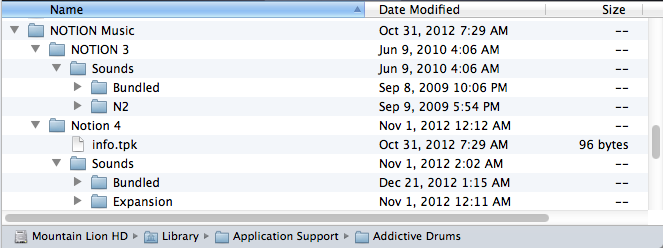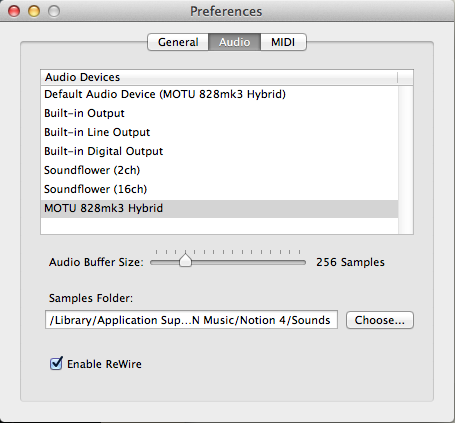jazzeck wrote:Hi there. Is it just me or is the classical guitar not working in 64 bit mode?
I'm just asking to be sure if it is not me who are doing something wrong...
And by the way, what is the difference between 64 bit and 32 bit. is there a significant difference in performance?
Some of the complete set of NOTION 4 native instruments are included with NOTION 4, and they are the "bundled" native instruments, but there are additional instruments which are sold as expansion sounds, and in this instance it appears that the Classical Guitar is one of the expansion sound instruments, hence you need to purchase the Classical Guitar expansion sounds . . .
NOTION 4 Expansion Sounds (Notion Music)Another possibility is that you never downloaded and installed the NOTION 4 bundled instruments, hence you are using the NOTION 3 bundled instruments, since it could be the case that some of the Classical Guitar stuff is included but not all the articulations, styles, and so forth, which is the way it works for pitch percussion, where some of the pitched percussion is included in the NOTION 4 bundled instruments but the full set requires getting the Expansion Sounds for pitch percussion and so forth . . .
Regarding 32-bit verus 64-bit, the primary difference is that 32-bit applications are limited to using at most approximately 4GB of memory, and this limitation reduces the amount of work that can be done in a single NOTION 4 score with respect to VSTi virtual instruments and so forth . . .
When NOTION 4 is run in 64-bit mode, it is using native 64-bit instructions and variables, and it can use more memory, all of which maps to optimized performance, significant memory space, and generally improved everything, hence if your computer supports it, you want to run everything in 64-bit mode whenever possible . . .
Currently, nearly every VSTi virtual instrument is available in 64-bit mode with the exception of the IK Multimedia VSTi virtual instruments, which at present are available only in 32-bit versions . . .
IK Multimedia is working on a 64-bit version of its SampleTank engine, and this probably will include updated sampled sound libraries, perhaps at a higher resolution, but to the best of my knowledge at the moment NOTION 4 continues to support standard CD quality audio, which is 44.1-Hz at 16-bits, so it mostly is a matter of getting the engine working in 64-bit mode rather than providing higher resolution sampled sound libraries . . .
And there is a significant difference in performance, where NOTION 4 running in 64-bit mode is not constrained in the way that NOTION 4 is constrained when running in 32-bit mode, which also is the case for NOTION 3, which only runs in 32-bit mode and is easily overwhelmed by what I call "heavy" VSTi virtual instruments, with MachFive 3 (MOTU) running in 32-bit mode being a "heavy" VSTi virtual instrument, where for example a NOTION 3 score on the Mac running in Mac OS X 10.8.2 can handle perhaps two instances of MachFIve 3 without becoming overwhelmed to the point that the audio skips, drops-out, and generally is degraded. For other types of VSTi virtual instruments the general upper limit in NOTION 3 is 20 to 25 instances, where one "instance" maps to one "staff" . . .
In my testing of NOTION 4 running in 64-bit mode, I have encountered no problems running three instances of MachFive 3, and there generally is plenty of memory space available, since I have 20GB of memory on the 2.8-GHz 8-core Mac Pro (early 2008) here in the sound isolation studio, where I plan to do additional memory upgrades to get the total memory to 32GB . . .
Regarding instructions and so forth, when an application runs in 32-bit mode, it is running in a scaled, compatibility type of "sandbox" that does not use the full capabilities of the processors, but when an application runs in 64-bit mode it is able to use native 64-bit instructions, and these instructions use the full capabilities of the operating system, various application programming interfaces (API), and foundation classes where downward conversions and substitutions are not required, which in the grand scheme of everything maps to
significantly increased performance as well as plenty of space to do everything . . .
And for VSTi virtual instruments that are available only in 32-bit mode, there are "bridging" utilities that allow them to be used when NOTION 4 is running in 64-bit mode, and Vienna Symphonic Library (VSL) has an application which does general bridging as well as advanced audio streaming (Vienna Ensemble Pro 5), which looks to be both nice and not so expensive . . .
Vienna Ensemble Pro 5 (Vienna Symphonic Library)For the IK Multimedia VSTi virtual instruments and 64-bit mode, all I can do is guess, and at present my best guess is that SampleTank will be 64-bits sometime this year (2013), hopefully by Spring or Summer, but this is just a guess, and the only information IK Multimedia is providing is that they are working on it, although all their T-RackS, Classik Studio Reverb (CSR), and ARC System 3 effects plug-ins are 64-bit and working very nicely, hence the only missing component is 64-bit SampleTank, where for reference SampleTank is the engine for all the IK Multimedia VSTi virtual instruments . . .
Yet another advantage of running in 64-bit mode is that this makes the advanced functionality of 64-bit ReWire 2 (Propellerhead Software) available, which among other things on the Mac makes it possible to use NOTION 4 External MIDI staves to control Reason 6.5 (Propellerhead Software) synthesizers and other instruments, including the the new Rack Extension, where on the Mac you can have DIgital Performer 8 (MOTU) running in 64-bit mode as the ReWIre 2 host controller and then have both NOTION 4 and Reason 6.5 running in 64-bit mode as ReWire 2 slave applications, which in turn makes it possible for NOTION 4 to control Reason 6.5 synthesizers and instruments in addition to NOTION 4 being able to control VSTi virtual instruments . . .
Explained another way, if your computer hardware and operating system fully support 64-bit computing, then running NOTION 3 or NOTION 4 in 32-bit mode greatly limits the amount of hardware, memory, and processors that you can use, but when you run NOTION 4 in 64-bit mode, you then can use the full capabilities of your computer and its operating system, with an example being that when NOTION 3 (which only runs in 32-bit mode) is running on the 2.8-GHz 8-core Mac Pro (early 2008) with 20GB of memory, it is able to use only 4GB of memory and perhaps 15 percent of the 8-cores, but when NOTION 4 is running in 64-bit mode, it can use as much of the 20GB of memory as it needs, and the core utilization is not restricted, hence it becomes possible and practical for the Mac Pro to be used as a supercomputer, which is what it is by design, which in some respects makes it a matter of Tinker Toy® (32-bit) versus Apple Super Computer (64-bit), which is fabulous . . .
Fabulous! 


